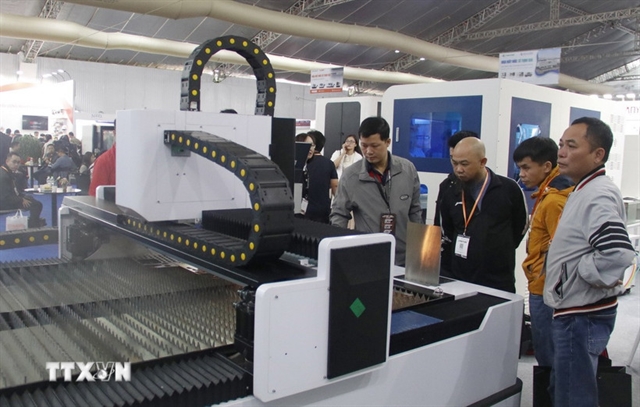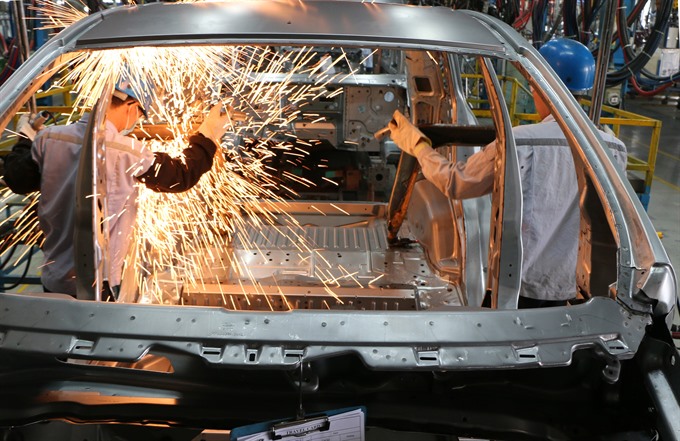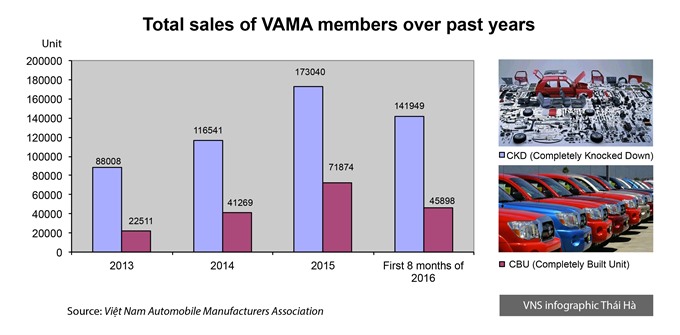 Economy
Economy

Back in the 1940s and 1950s, the Japanese government was facing a question it found hard to answer: should it develop the automobile industry?
 |
By Ngọc Bích & Xuân Hương
HÀ NỘI — Back in the 1940s and 1950s, the Japanese government was facing a question it found hard to answer: should it develop the automobile industry?
There was stark division on the issue, with some arguing that if the country could import vehicles from other countries, it did not seem essential to develop the products oneself.
However, thanks to the implementation of several policies supporting the production of auto parts and components, the country is now among the world’s giant auto manufacturers with many well-known brands.
The story could be a very good lesson for Việt Nam, which is also seeking answers to a similar question, Nguyễn Thị Xuân Thúy, director of the Integration Policy and Strategy Division under the Institute of Industrial Policies and Strategies (IIPS), said.
There are justifiable reasons to pose this question.
In two years, the tariff on complete-built-in (CBU) units on automobiles imported from ASEAN nations will be zero per cent under the ASEAN Free Trade Agreement. So consumers will be able to purchase new cars without paying as much money as they currently do.
In particular, the local part supply industry is still underdeveloped, not to mention concerns over environmental problems potentially caused by the industry.
Thúy said “Domestic manufacturing and assembling enterprises in the country still have to import automobile spare parts from various sources such as ASEAN, Japan, China, South Korea and Europe.”
“The import raises the production costs directly due to import tax and indirectly through additional costs such as transportation.”
Vũ Quang Tâm, deputy general director of Honda Việt Nam, once told a Vietnam News Agency correspondent that unlike the production of motorbikes, for which the localisation rate (the percentage of locally-made components used to assemble a bike) reached nearly 97 per cent, the rate of the automobile industry was still very low.
In a recent conference on industry development, the average localisation rate was reported to be much lower than the target of an average 40 per cent set for 2020 and 60 per cent for 2025.
Tâm explained that the size of the Vietnamese automobile market is not large enough to attract investors to manufacture auto parts and components.
Thúy agreed, saying “The scale of the market is now much smaller than other countries’ in the region (only equivalent to one-fifth of Thailand or one-sixth of Indonesia).”
“With such a small scale, we don’t have any advantage of scale. That’s why the local production cost of a vehicle is 20 per cent higher than that of other ASEAN countries.”
Phạm Văn Tài, Permanent Deputy Director of Trường Hải Auto Corporation (THACO) admitted "With deeper international integration, especially after 2018, local auto manufacturing and assembling firms like THACO will face severe competition from auto firms in ASEAN member countries."
Despite having high localisation rate (15-20 per cent for passenger cars, 35-45 per cent for trucks and 50-65 per cent for buses), the company still have to find ways to overcome the common difficulties caused by modest market size, Tài said.
Honda Việt Nam leader Tâm added that the part supply industry was facing hardship, partly due to the Government’s support policies which had not fully worked.
For instance, some part suppliers of the company had to import steel and iron from abroad because most steel and iron products produced domestically were serving the construction industry.
Trần Thanh Văn, general director of Dry Cell and Storage Battery Joint Stock Company (PINACO) which supplies batteries to many leading automotive and motorbike makers, said 60-70 per cent of the materials needed for production are imported.
“Therefore, policies related to monetary and exchange rates and fluctuations on the international market affect us.”
Besides this, there is unfair competition between locally made batteries and imported ones since importers usually declare lower prices to evade tax.
He said “While local battery producers are bound by regulations on environment and responsible for used batteries, importers are not bound by such regulations.”
Văn suggested that the Government create a sound competitive environment in which all businesses have the same responsibilities in terms of tax, environment and other issues.
Thúy from IIPS also said the implementation of tax reduction for spare part imports as committed between Việt Nam and Japan was slower than other regional countries because Việt Nam had signed the economic partnership agreement with Japan later compared with the other nations.
 |
According to Thúy, if Việt Nam is not going to continue producing or assembling vehicles, it will not only have a negative effect on auto makers, but also result in lost opportunities to develop other potential related sectors, such as mechanical engineering, rubber, plastics, electronics and magnet wire.
In fact, the automobile market in Việt Nam is considered very prospective.
According to experts, the potential of a country’s automotive market is assessed based on factors such as the size and structure of the population, the per capita income, the number of vehicles per 1,000 inhabitants and the development of infrastructure.
“It can be seen that the elements of population, income and infrastructure conditions are favourable for the development of the Vietnamese automotive market in the next 10 years,” Thúy said.
Regarding the population, Việt Nam has over 90 million inhabitants and the population of the middle class is growing with per capita income estimated to reach the threshold of US$$3,000 in 2020.
Việt Nam’s automobile market is expected to enter the stage of motorisation in the 2020-2025 period when automotive consumption rate (motorisation) will reach 50 vehicles per 1,000 inhabitants, Thúy said.
Road traffic systems are growing strongly with intercity connection through a network of highways, which will also create more favourable conditions for traveling by private cars, she added.
According to Thúy, with the presence of the world’s large manufacturers and automobile assemblers, such as Toyota, Honda, Ford, GM and Mecedes-Benz, it will be unfortunate if Việt Nam cannot take advantage of this opportunity to build an automotive industry and foster the growth of the auto parts sector.
Việt Nam now has a vast network of part suppliers for motorbike production, which is the basic foundation for the development of the auto parts industry, Thúy said.
“Without the domestic automotive industry, in the future, when the needs of the Vietnamese people increase, Việt Nam will have to import a large amount of new CBU and even used ones from abroad, which will put pressure on trade balance and raise environmental issues.”
Besides this, when the motorbike industry is saturated, if the automotive industry does not grow, suppliers of motorbike parts will not have a chance to continue their operation.
Honda Việt Nam Deputy General Director Tâm said auto consumption is an obvious trend. However, to develop the industry, it is necessary to develop co-operation among ministries and agencies to define “which market segment should we focus on.”
It would make priority policies more focal and effective, he said, adding that related ministries should seek common ground on the issue.
Currently, the Ministry of Industry and Trade wants to increase the scale of the market, while the Ministry of Transport is facing pressure of infrastructure development and the Ministry of Finance tends to limit the purchase of personal cars by imposing more fees.
Thúy suggested that Việt Nam learn by example from the experiences of other regional countries to develop specific and suitable planning for the domestic automobile industry.
Among ASEAN nations, currently there are five countries manufacturing vehicles -- Thailand, Malaysia, Indonesia, Philippines and Việt Nam.
The four neighbouring countries already have policies and programmes in place to promote the industry with clear incentives for businesses or vehicle segments that meet the conditions set.
Notably, Thailand has developed a programme on eco cars, Indonesia is producing low cost green cars, Malaysia has established a fund to assist domestic car assembly and the Philippines has enacted a new comprehensive strategy to rebuild the automotive industry.
In the future, the Vietnamese automobile industry will need to overcome the pressure of competition after 2018, narrow the gap in production costs, take advantage of FTAs to increase exports of spare parts and participate in the world and region’s supplying chains.
Recently, Professor Kobayashi Hideo from Waseda University, an expert in auto industry, shared with Vietnamese local media some policies that helped Japan succeeded in developing the industry. One of them is to grant certificates for qualified auto parts and components to encourage the producers. – VNS
Lê Nguyễn Duy Oanh, Deputy Director of the HCM City Department of Industry and Trade’s Centre of Supporting Industries Development. The Government issued Decree No111/2015/ND-CP on developing the parts industry with incentives for enterprises operating in the sector. The HCM City People’s Committee has also promulgated a programme to boost the development of the city’s parts industry, including a comprehensive study of the industry and establishment of the Centre of Supporting Industries Development. It also has a policy of providing preferential loans to firms in manufacturing as part of its investment stimulus programme under Decision 50/2015/ QĐ-UBND. The auto parts industry consists of the mechanical engineering, rubber, plastic, electronic, and magnet wire sectors, which are among priority sectors in the city’s investment stimulus programme. As the co-ordinator of the steering committee for developing the parts industry, the Department of Industry and Trade and the centre have organised events to connect domestic parts producers with producers of downstream products seeking suppliers in the city. We also organised an international supporting industries exhibition and seminar to help businesses promote their products and expand their production capacity and enable them to link up with local and foreign partners to enter the global supply chain. The centre plans to connect local parts producers in the mechanical engineering, rubber, plastics, electrical, and electronics and IT sectors with domestic and foreign auto manufacturers and assemblers, including Daehan Motors, Samco and other foreign companies who JICA and the Ministry of Industry and Trade have good relations with. To become suppliers, parts producers have to meet strict requirements in terms of quality, production management system and so on. They can take part in the city’s investment stimulus programme to obtain loans for buying more machinery and equipment. It may take many years for a local company to be able to join the supply chain of a multinational company. Tâm Hợp Co, Ltd in Hà Nội is an example. It took three years for the company to become a Tier-2 parts supplier for Toyota, but after that the company’s growth rate increased strongly. Toyota sent its experts to work directly with Tâm Hợp for months to help the company make products meeting its requirements. We will strive to implement this method in HCM City. We will work to create a database of businesses in the parts industry to make it easier for downstream producers, including foreign ones, to find parts suppliers. In addition, we will organise seminars on the parts industry and expand the showroom for displaying supporting industry products.
Phạm Văn Tài, Permanent Deputy Director of Trường Hải Auto Corporation (THACO) THACO manufactures, assembles and distributes automobiles and auto components and provides maintenance services. In response to the Quảng Nam Province People’s Committee’s call for investment, in 2003 THACO invested in building the Chu Lai-Trường Hải Auto Manufacture and Assembly Complex on an area of nearly 600 hectares. Now the complex is home to five automobile assembly and 12 parts manufacturing plants. THACO has 12 parts manufacturing plants which play an important role in the company’s production activity by providing inputs for THACO’s production units and services subsidiaries. With its high production capacity and large output, in addition to catering to the company’s production needs, THACO also supplies other companies in Việt Nam and exports to Malaysia, South Korea and other countries. The auto market has grown rather strongly. An increase in per capita income and improved transport infrastructure are among the factors that positively affect demand for automobiles. AFTA is a challenge but also an opportunity for the company to expand market share and participate in the global supply chain. In the country’s automobile industry development strategy through 2020, the Government affirms the importance of developing the components industry. THACO has also mapped out a strategy to develop the auto parts industry. To implement the strategy to develop the auto components industry at the Chu Lai Open Economic Zone in Quảng Nam Province, the company will increase local parts use through three methods - joint venture and co-operation with domestic and foreign partners, investing and soliciting investment in the Chu Lai-Trường Hải Auto Mechanical Industrial Park and supporting domestic small and medium-sized enterprises in moving up to industrial-scale production. THACO has a strategy to participate in the global auto and auto parts value chain. In addition, it focuses on investing in and promoting R&D and creating conditions to attract local and foreign partners to invest in the auto parts industry to increase the use of local components and boost exports.
Trần Thanh Văn, General Director of Dry Cell and Storage Battery Joint Stock Company (PINACO) PINACO offers a wide range of batteries meeting most automobile makers’ requirements covering cars, trucks, motorcycles, electric vehicles, electric bikes as well as other applications such as lighting, UPS, and rechargeable lamps. PINACO supplies batteries to many famous automotive and motorbike makers such as Ford Vietnam, Vietnam Suzuki, Mercedes-Benz Vietnam, THACO, Honda Vietnam, Hyundai Vinamotor, Vina Mazda, KIA Motor, Mekong Auto, Samco, Honda Vietnam, Piaggio Vietnam, and Yamaha Vietnam. PINACO’s batteries are also exported to 31 countries and territories. We enjoyed a growth rate of 15-17 per cent in the last three years. Automobile production has increased significantly due to Việt Nam’s economic development, families tending to buy more automobiles and the Government’s policy to curb overloaded trucks. This is an advantage for the company. PINACO is already very strong in supplying batteries to the automobile, motorbike and lighting sectors. Renewable energy, post and telecom base stations, electric automobiles and bikes are among sectors the company can supply in the coming time. — VNS |




